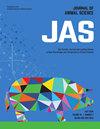Fecal Microbiota-based Investigations of Nitrogen Utilization Efficiency and related Traits in a Landrace x Piétrain crossbred Population
IF 2.7
2区 农林科学
Q1 AGRICULTURE, DAIRY & ANIMAL SCIENCE
引用次数: 0
Abstract
Improving protein efficiency in pork production is a desired goal regarding resource conservation and climate protection, whereby animal breeding has great potential for sustainable improvements. Nitrogen utilization efficiency (NUE) is an important trait but laborious to measure. As blood urea nitrogen (BUN) can be used to predict NUE, it is often used as indicator trait. Both NUE and BUN were found to be heritable, however, microbial studies have not yet been carried out. The present study aimed to investigate the role of the gastrointestinal microbiota in the context of N efficiency in different fattening phases. The dataset consisted of 450 Landrace x Piétrain pigs fattened in a two-phase feeding regime. All pigs were fecal sampled and phenotyped in two fattening phases, referred to as sampling period (SP) 1 and SP2 in week 13 and week 16 post natum, respectively. Microbial communities in feces were compared across SPs and significant differences were observed. Mixed linear models were applied to quantify the microbial variance and microbiability for NUE, BUN, and related traits within each of the SPs. Except for NUE in SP1, all microbiabilities were significant and ranged from 0.079 to 0.471. Microbiome-wide association studies revealed a polymicrobial trait architecture, characterized by the contribution of many genera, with each genus having a relatively small effect on the traits. In total, four and eleven microbial genera were significantly associated with NUE and BUN, respectively. Microbial correlations were estimated between traits within SPs via bivariate analyses. Blood urea nitrogen was significantly correlated with N intake and retention in SP1 but not in SP2. Fecal microbiota composition differed significantly between SPs and the use of microbiota data across SPs resulted in a remarkable drop in microbiability for nearly all traits. This implies that microbiota data should be representative of the time point of phenotyping to fully capture microbial contribution to trait expression. The results suggest that jointly using genomic and fecal microbial data might be expedient to improve protein efficiency in fattening pigs.基于粪便微生物群的长皮杂交种氮素利用效率及相关性状研究
提高猪肉生产中的蛋白质效率是资源节约和气候保护方面的理想目标,因此动物育种具有可持续改进的巨大潜力。氮素利用效率(NUE)是一个重要的指标,但测量起来比较困难。由于血尿素氮(BUN)可以预测nuue,因此常被用作指标性状。NUE和BUN均可遗传,但尚未进行微生物研究。本研究旨在探讨不同育肥阶段胃肠道微生物群对氮效率的影响。该数据集由450头长白猪和pisamutrain猪组成,饲养方式为两阶段。在两个育肥阶段(分别为取样期(SP) 1和取样期(SP) 2)对所有猪进行粪便取样和表型分型,取样期分别为产后第13周和第16周。比较了不同SPs的粪便微生物群落,发现存在显著差异。采用混合线性模型量化每个SPs中NUE、BUN和相关性状的微生物方差和微生物可微生物性。SP1除NUE外,其余微生物率均显著,范围为0.079 ~ 0.471。微生物组关联研究揭示了一种多微生物性状结构,其特征是许多属的贡献,每个属对性状的影响相对较小。共有4个和11个微生物属分别与NUE和BUN显著相关。通过双变量分析估计了SPs性状之间的微生物相关性。血尿素氮与氮素摄入和滞留在SP1期呈显著相关,而在SP2期无显著相关。粪便微生物群组成在SPs之间存在显著差异,并且在SPs之间使用微生物群数据导致几乎所有性状的微生物性显着下降。这意味着微生物群数据应该代表表型的时间点,以充分捕捉微生物对性状表达的贡献。结果表明,将基因组数据与粪便微生物数据结合使用可能有利于提高育肥猪的蛋白质效率。
本文章由计算机程序翻译,如有差异,请以英文原文为准。
求助全文
约1分钟内获得全文
求助全文
来源期刊

Journal of animal science
农林科学-奶制品与动物科学
CiteScore
4.80
自引率
12.10%
发文量
1589
审稿时长
3 months
期刊介绍:
The Journal of Animal Science (JAS) is the premier journal for animal science and serves as the leading source of new knowledge and perspective in this area. JAS publishes more than 500 fully reviewed research articles, invited reviews, technical notes, and letters to the editor each year.
Articles published in JAS encompass a broad range of research topics in animal production and fundamental aspects of genetics, nutrition, physiology, and preparation and utilization of animal products. Articles typically report research with beef cattle, companion animals, goats, horses, pigs, and sheep; however, studies involving other farm animals, aquatic and wildlife species, and laboratory animal species that address fundamental questions related to livestock and companion animal biology will be considered for publication.
 求助内容:
求助内容: 应助结果提醒方式:
应助结果提醒方式:


